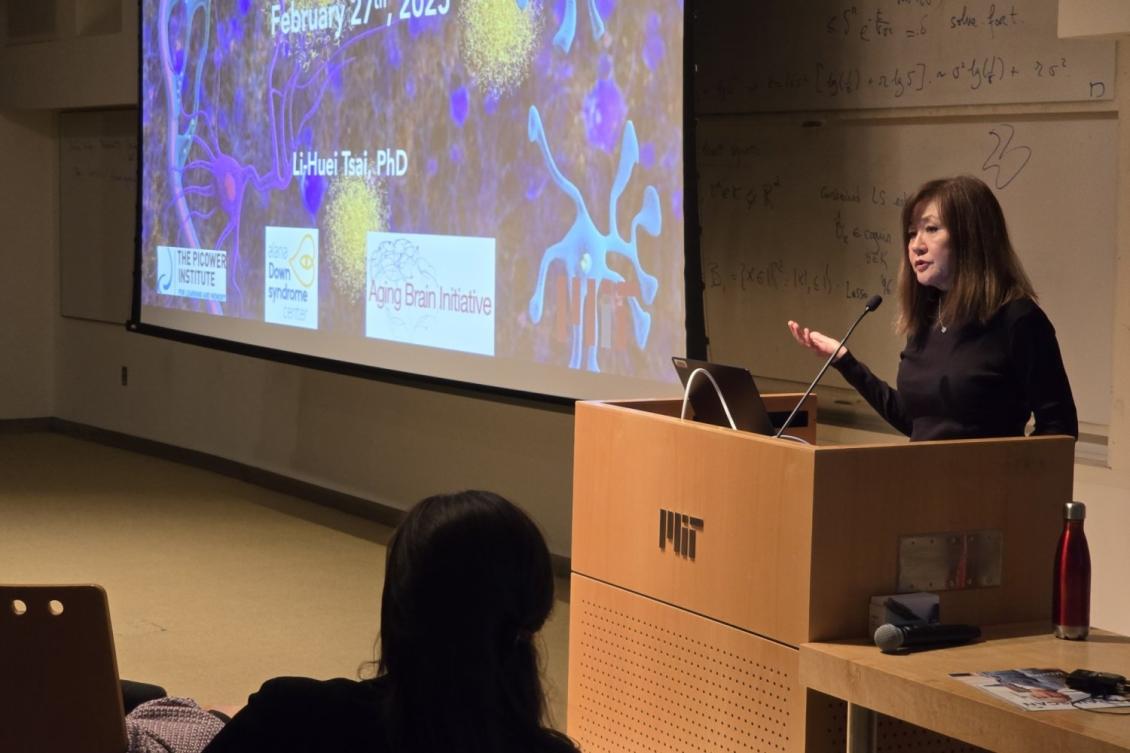Evidence that 40Hz gamma stimulation promotes brain health is expanding

A decade after scientists in The Picower Institute for Learning and Memory at MIT first began testing whether sensory stimulation of the brain’s 40Hz “gamma” frequency rhythms could treat Alzheimer’s disease in mice, a growing evidence base supporting the idea that it can improve brain health — in humans as well as animals — has emerged from the work of labs all over the world. A new open-access review article in PLOS Biology describes the state of research so far and presents some of the fundamental and clinical questions at the forefront of the noninvasive gamma stimulation now.
“As we’ve made all our observations, many other people in the field have published results that are very consistent,” says Li-Huei Tsai, Picower professor of neuroscience at MIT, director of MIT’s Aging Brain Initiative, and senior author of the new review, with postdoc Jung Park. “People have used many different ways to induce gamma including sensory stimulation, transcranial alternating current stimulation, or transcranial magnetic stimulation, but the key is delivering stimulation at 40 hertz. They all see beneficial effects.”
A decade of discovery at MIT
Starting with a paper in Nature in 2016, a collaboration led by Tsai has produced a series of studies showing that 40Hz stimulation via light, sound, the two combined, or tactile vibration reduces hallmarks of Alzheimer’s pathology such as amyloid and tau proteins, prevents neuron death, decreases synapse loss, and sustains memory and cognition in various Alzheimer’s mouse models. The collaboration’s investigations of the underlying mechanisms that produce these benefits have so far identified specific cellular and molecular responses in many brain cell types including neurons, microglia, astrocytes, oligodendrocytes, and the brain’s blood vessels. Last year, for instance, the lab reported in Nature that 40Hz audio and visual stimulation induced interneurons in mice to increase release of the peptide VIP, prompting increased clearance of amyloid from brain tissue via the brain’s glymphatic “plumbing” system.
Meanwhile, at MIT and at the MIT spinoff company Cognito Therapeutics, phase II clinical studies have shown that people with Alzheimer’s exposed to 40Hz light and sound experienced a significant slowing of brain atrophy and improvements on some cognitive measures, compared to untreated controls. Cognito, which has also measured significant preservation of the brain’s “white matter” in volunteers, has been conducting a pivotal, nationwide phase III clinical trial of sensory gamma stimulation for more than a year.
“Neuroscientists often lament that it is a great time to have AD [Alzheimer’s disease] if you are a mouse,” Park and Tsai wrote in the review. “Our ultimate goal, therefore, is to translate GENUS discoveries into a safe, accessible, and noninvasive therapy for AD patients.” The MIT team often refers to 40Hz stimulation as “GENUS” for Gamma Entrainment Using Sensory Stimulation.
A growing field
As Tsai’s collaboration, which includes MIT colleagues Edward Boyden and Emery N. Brown, has published its results, many other labs have produced studies adding to the evidence that various methods of noninvasive gamma sensory stimulation can combat Alzheimer’s pathology. Among many examples cited in the new review, in 2024 a research team in China independently corroborated that 40Hz sensory stimulation increases glymphatic fluid flows in mice. In another example, a Harvard Medical School-based team in 2022 showed that 40Hz gamma stimulation using Transcranial Alternating Current Stimulation significantly reduced the burden of tau in three out of four human volunteers. And in another study involving more than 100 people, researchers in Scotland in 2023 used audio and visual gamma stimulation (at 37.5Hz) to improve memory recall.
Open questions
Amid the growing number of publications describing preclinical studies with mice and clinical trials with people, open questions remain, Tsai and Park acknowledge. The MIT team and others are still exploring the cellular and molecular mechanisms that underlie GENUS’s effects. Tsai says her lab is looking at other neuropeptide and neuromodulatory systems to better understand the cascade of events linking sensory stimulation to the observed cellular responses. Meanwhile, the nature of how some cells, such as microglia, respond to gamma stimulation and how that affects pathology remains unclear, Tsai adds.
Even with a national phase III clinical trial underway, it is still important to investigate these fundamental mechanisms, Tsai says, because new insights into how noninvasive gamma stimulation affects the brain could improve and expand its therapeutic potential.
“The more we understand the mechanisms, the more we will have good ideas about how to further optimize the treatment,” Tsai says. “And the more we understand its action and the circuits it affects, the more we will know beyond Alzheimer’s disease what other neurological disorders will benefit from this.”
Indeed, the review points to studies at MIT and other institutions providing at least some evidence that GENUS might be able to help with Parkinson’s disease, stroke, anxiety, epilepsy, and the cognitive side effects of chemotherapy and conditions that reduce myelin, such as multiple sclerosis. Tsai’s lab has been studying whether it can help with Down syndrome as well.
The open questions may help define the next decade of GENUS research.

